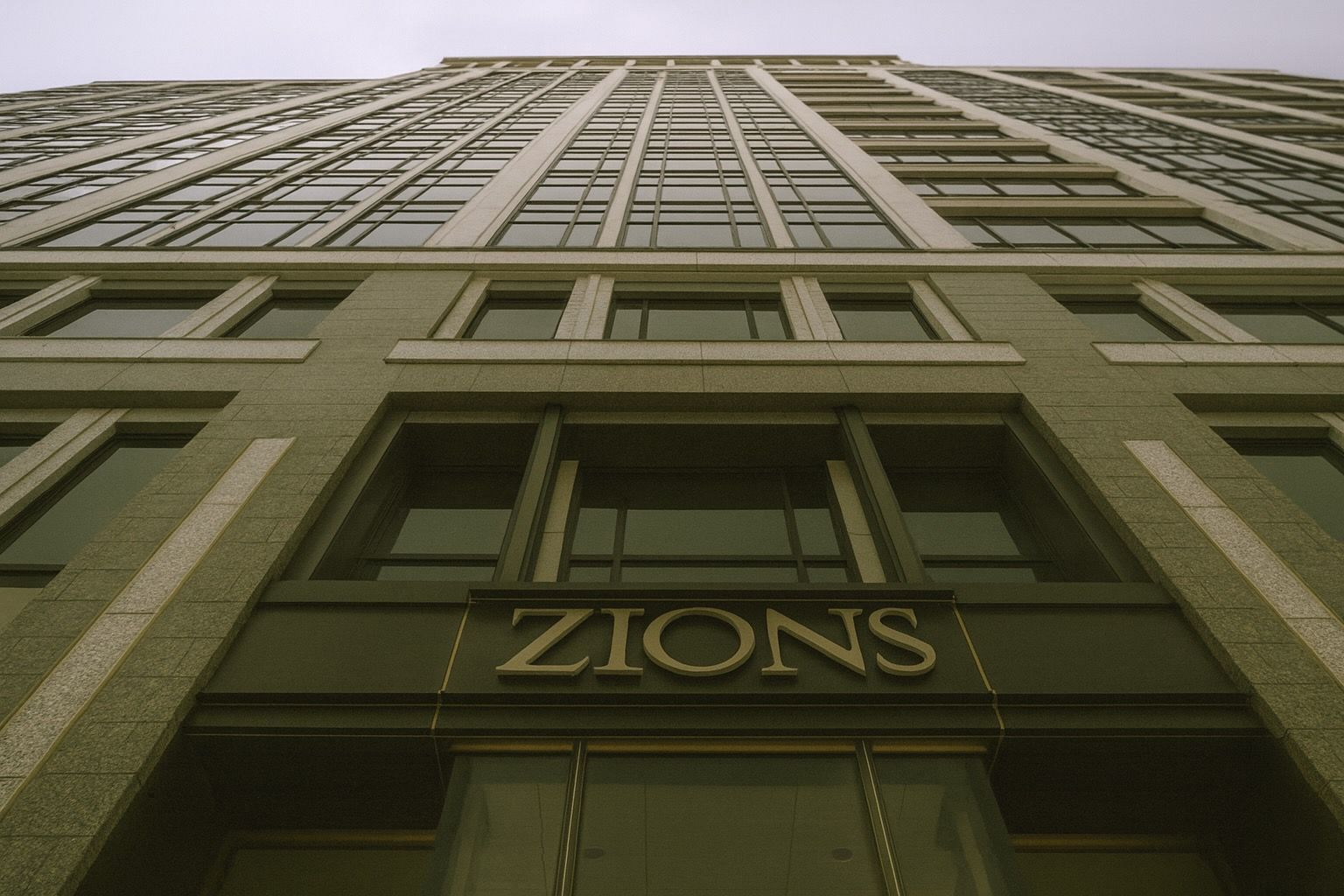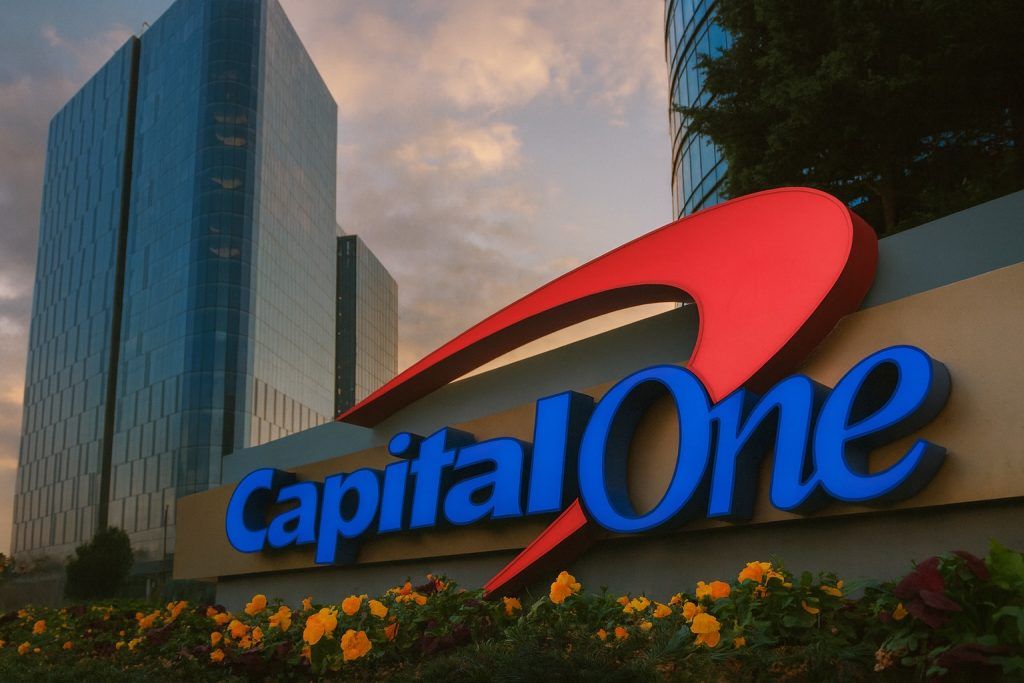- Surprise Loan Loss: Zions Bancorporation (NASDAQ: ZION) stunned investors by disclosing it will charge off $50 million on two large business loans after uncovering “apparent misrepresentations and contractual defaults” by the borrowers [1]. The loans, totaling about $60 million, were made by Zions’ California Bank & Trust division, and the bank has set aside funds (a provision) for the full amount while pursuing legal action to recover the money [2].
- Stock Tumbles:ZION stock plunged ~12–13% on Oct. 16, 2025, falling into the high-$40s per share after the news broke [3]. The unexpected loss sparked broader fears about credit quality in regional banks, sending the regional bank index down nearly 4–6% and dragging down peer bank stocks [4] [5].
- Peer Fallout: Shares of Western Alliance Bancorp (WAL) sank about 11% in sympathy [6]. WAL revealed in its own filing that it had a related exposure – a revolving credit facility to the same troubled borrower – and had already filed a fraud lawsuit back in August [7]. Western Alliance’s management assured investors that existing collateral covers its loan and affirmed that its overall “criticized” weak assets have declined since June [8] [9].
- Analyst Alarm: Wall Street analysts were quick to weigh in. Piper Sandler cut Zions’ price target from $62 to $59 (maintaining a Neutral rating) in light of the surprise charge-off [10]. Raymond James warned the incident “puts into question Zions’ underwriting standards and risk management”, given the bank typically specializes in smaller business loans [11]. Truist Securities noted there have been enough “one-offs” in bank credit events lately that “investors are selling first and asking questions later.” [12] At the same time, analysts at Stephens stressed that Zions considers this an isolated event unrelated to recent high-profile bankruptcies in the sector [13].
- Outlook – One-Off or Red Flag?: Zions insists this is an “isolated situation”, and experts say the onus is on management to prove it’s a one-off problem not indicative of broader issues [14]. The bank reports Q3 2025 earnings on Oct. 20, which will include the $50M charge-off hit. Notably, ZION stock is down ~10% year-to-date and still ~22% below its 52-week high (~$61.73) even after a summer rebound [15]. Analysts’ consensus on the stock is cautious – an average “Hold” rating – but with an average price target around $61–62, implying potential upside if the bank can put these credit scares to rest [16] [17]. The coming earnings call will be a pivotal moment for Zions to reassure investors that this fraud-related loss is contained. Any further surprises could deepen the “hidden credit stress” fears that have rattled the entire regional banking group [18] [19].
Fraudulent Loan Bombshell Hits Zions’ Books
Zions Bancorporation shocked the market this week by revealing a significant credit mishap at its California division. In a late Wednesday 8-K filing, the Salt Lake City-based regional bank disclosed it discovered potential fraud in two related commercial loans totaling about $60 million [20]. After an internal review unearthed “misrepresentations and irregularities” by the borrowers, Zions decided to write off $50 million of the loans and take a provision for the rest, effectively recognizing a total $60 million exposure as likely lost [21]. The bank has already accelerated the loans to default and filed a lawsuit in California against the guarantors in an effort to recover the funds [22] [23].
“The optics of a large balance C&I loan to a fraudulent borrower from a bank that specializes in small balance C&I loans is not great,” wrote Raymond James analysts, noting the news raises questions about Zions’ risk management and underwriting practices [24]. Zions primarily serves small and mid-sized businesses across 11 Western and Southwestern states, so a $60 million loan to what appears to be an independent investment fund is outside its usual profile [25] [26]. This may explain why the bank was caught off-guard – the borrowers had attracted legal actions from other lenders, tipping off Zions to possible fraud only recently [27] [28].
Crucially, Zions’ management maintains that this event is a singular case. “The Bank believes this is an isolated situation,” the filing stated, though it has hired outside counsel to conduct an independent review to be sure [29]. Still, the timing raised some eyebrows on Wall Street. Truist analyst David Smith pointed out that other banks disclosed their loan losses tied to recent bankruptcies (such as subprime lender Tricolor and auto-parts maker First Brands) weeks ago, whereas Zions’ issue surfaced later with little warning [30]. This fueled speculation about whether Zions’ troubled loans are truly unrelated to those high-profile failures or if something was missed. Zions has indicated the problematic loans were made to “an independent investment fund” (not to a now-bankrupt operating company), suggesting no direct link to the First Brands or Tricolor bankruptcies [31].
Market Reaction: Stock Plunges as Regional Bank Jitters Return
Investors reacted swiftly and harshly to Zions’ announcement. The morning after the disclosure, ZION shares opened sharply lower and continued sliding, ultimately closing down about 13% on Thursday [32]. This one-day plunge wiped out roughly $600–700 million in market value and sent the stock to its lowest levels in months (around the upper-$40s per share). The steep drop reflects both the direct financial impact – a $50 million charge-off will hit Zions’ third-quarter earnings – and broader fears of what else could be lurking on bank balance sheets. “Hidden credit stress” is the phrase Reuters used, as investors are increasingly anxious that more loans could go bad in an environment of high interest rates and economic uncertainty [33].
The shock from Zions quickly spread to other regional banks. Western Alliance (WAL), a Phoenix-based peer, saw its stock nosedive around 11% on Oct. 16 [34]. Western Alliance wasn’t directly involved in Zions’ loans, but it disclosed its own brush with the situation – the bank said it had a lending relationship with a related borrower and in August filed a fraud lawsuit against that party, alleging the borrower failed to provide proper collateral [35]. Western Alliance emphasized that it believes the collateral it does have is sufficient and affirmed its prior guidance for 2025, attempting to “pare losses” and calm the market [36] [37]. Nonetheless, the fact that another respected regional bank was even tangentially caught up in a fraud scenario shook confidence across the sector.
Beyond these two, investors punished any bank seen as potentially exposed to risky loans. The KBW Regional Banking Index (KRX) fell roughly 4–6% on the day [38]. Even banks with no direct connection felt the pain, illustrating how fragile sentiment remains. For example, investment bank Jefferies (JEF) – which has been dealing with fallout from the First Brands bankruptcy – dropped about 10% as the Zions news hit, on fears of “what’s next” in credit surprises [39]. As one TS2 Tech analysis put it, on October 16 “regional banks faced trouble” with Zions’ charge-off rattling the group and reminding investors that smaller banks can be swiftly repriced on perceived credit risks [40].
It’s worth noting that this setback for regional banks comes on the heels of a short-lived rebound in sentiment. Earlier in the week, big Wall Street banks reported strong Q3 earnings, sparking a brief rally in bank stocks (including a ~3.5% uptick in ZION stock two days prior) [41]. Large banks like JPMorgan and Wells Fargo beat expectations, citing robust trading revenues and net interest income, which buoyed optimism that the banking sector was on solid footing [42]. In addition, Federal Reserve Chair Jerome Powell had hinted at easing back on quantitative tightening, a positive sign for market liquidity [43]. All of that good news was swiftly overshadowed by Zions’ surprise disclosure – a reminder that idiosyncratic problems can quickly sour the mood. “When you see one cockroach, there are probably more,” JPMorgan’s CEO Jamie Dimon cautioned just days ago [44]. In the context of regional banks, Zions’ $50 million loan loss was the “cockroach” that investors feared might imply deeper infestations in the credit market.
Experts: “One-Off” Event or Sign of Wider Credit Issues?
The central question now is whether Zions’ loan fiasco is an isolated blunder or a warning sign of broader credit weakness among mid-sized banks. Analysts are divided, but most emphasize that the burden is on Zions to show this was a unique case. “Zions faces the challenge of showing that this is a one‐off event and not indicative of broader … credit control weakness,” said Brian Mulberry of Zacks Investment Management [45]. In other words, management must demonstrate in coming quarters that its underwriting and oversight are sound apart from this one aberration. To that end, Zions noted that it engaged independent counsel to review the incident, and the bank stressed that it proactively launched an internal investigation as soon as it learned other lenders had raised flags about the borrowers [46] [47].
Some analysts do take comfort in the notion that this appears to be an idiosyncratic, borrower-specific failure. “Bankruptcies and fraud are natural in markets, but it doesn’t always lead to something systemic,” observed David Wagner, head of equities at Aptus Capital, urging perspective [48]. Analysts at Keefe, Bruyette & Woods (KBW) similarly noted that after high-profile collapses like First Brands and Tricolor, “investors are rightfully on high alert for any change in asset quality trends,” yet so far these incidents seem tied to individual problem borrowers rather than a broader meltdown [49]. In Zions’ case, the borrowers in question were affiliated with an investment fund (reportedly in the non-depository financial institution “NDFI” category) and not with any well-known corporate name, which may indicate a contained issue [50]. Stephens analyst Terry McEvoy pointed out that the problematic loans “are not connected to the recent bankruptcy announcements” in the sector, reinforcing that this was a separate rogue lending situation [51].
However, other experts warn that even isolated credit events can erode investor trust – especially coming so soon after a string of “one-off” surprises at various banks. “There have been enough ‘one-offs’ in commercial credits for banks of late that investors are selling first and asking questions later,” wrote Truist’s David Smith [52]. Indeed, Zions is not alone in springing an unpleasant surprise: over the past year, numerous regional banks have disclosed unexpected write-downs, from office commercial real estate losses to fraud-related charges. Each incident by itself might be idiosyncratic, but together they feed a narrative that bank balance sheets may harbor more mines. As Bloomberg Intelligence analyst Herman Chan remarked, “Zions’ credit issue is raising questions on asset quality across the KRX (regional bank index).” [53] If nothing else, the episode has put regional bank investors on edge. Confidence is fragile, and as Jamie Dimon’s “cockroach” analogy implies, the market will assume the worst (that there are more problems unseen) until banks prove otherwise [54].
The magnitude of Zions’ charge-off also drew attention. A $50 million loss is significant for a regional bank of Zions’ size – for context, Zions’ net income was around $250 million last quarter (Q2 2025). Piper Sandler’s analyst Matthew Clark noted that Zions’ discovery of possible fraud and quick action to write off the loans shows vigilance, but it understandably makes investors question the bank’s loan monitoring [55]. Raymond James analysts criticized the bank’s risk controls, given that Zions let a large loan (or pair of loans) to a single borrower grow to $60 million before these red flags emerged [56]. Zions will likely face tough questions from analysts and shareholders about how these loans were originated and overseen – and what is being done to prevent similar issues. The bank may need to tighten its lending standards or exposure limits to certain borrowers, which could slightly slow its loan growth but improve quality. Encouragingly, Zions noted that apart from this incident, its overall loan portfolio trends (delinquencies, non-performers) have been stable. Western Alliance also reported that its total “criticized” (substandard) assets actually fell quarter-over-quarter, underscoring that overall credit quality remains healthy outside of isolated cases [57].
What’s Next: Earnings, Forecasts and Investor Sentiment
Looking ahead, Zions Bancorp will have an opportunity to regain control of the narrative when it releases third-quarter earnings on Monday, Oct. 20, 2025. Investors will be zeroed in on that report and conference call for clarity on the charge-off and the status of the lawsuit to recoup funds. Analysts expect Zions will still post a profit for Q3 – consensus EPS is around $1.45 (prior to adjusting for this charge) on roughly $840 million revenue [58] [59]. The $60 million provision could reduce earnings by roughly $0.30 per share (after tax), so the results may come in below prior forecasts. However, banks often have other levers (like releasing other reserves or expense tweaks) that could soften the blow. More important will be management’s commentary: investors want reassurance that this was an atypical loss and that no other shoes are about to drop. If Zions’ CEO and risk officers can convincingly detail why these loans slipped through and how processes are improving, it may go a long way toward rebuilding confidence.
From a stock perspective, analysts’ forecasts on ZION remain guardedly optimistic despite recent events. As noted, Piper Sandler trimmed its target price to $59 [60], which still represents about a 20% increase from current levels around $49. In fact, several analysts in late September had raised their targets into the mid-$60s or higher, citing improving net interest margins and efficiency at Zions [61]. The average 12-month price target is roughly $61–62 [62]. If one takes that at face value, it suggests the stock could rebound over 25% in the next year. Notably, ZION’s valuation has become more attractive after the sell-off – the stock now trades around 9× forward earnings, well below the market average, and sports a 3.4% dividend yield after a recent dividend hike [63] [64]. In other words, much of the bad news may be priced in, and any positive surprises (or simply the absence of new negatives) could let the stock recover.
That said, the consensus recommendation is essentially Hold [65]. According to GuruFocus data, out of about 24 brokerage firms covering Zions, most are on the fence – reflecting uncertainty about the economic outlook and bank sector in general [66]. Zions is not a “Strong Buy” on Wall Street’s scorecard right now, unlike some larger banks. It sits in that middle ground where bulls see an undervalued franchise with a solid regional footprint and steady deposit base, whereas bears see a bank still facing interest-rate and credit headwinds. The latest credit flap certainly tilts sentiment toward the cautious side. As one TS2.Tech commentary noted, “smaller banks can trade on the broad risk environment – interest rate worries, loan quality fears and regulation headlines all matter” [67].
Ultimately, Zions Bancorp’s trajectory in coming months will hinge on executing a twofold plan: (1) Convince the market that this $50M loan loss truly was a one-time anomaly (and that lessons have been learned), and (2) continue delivering respectable core results – e.g. stable net interest income, controlled expenses, and healthy capital ratios – to show the bank’s overall health. If it can do so, there is room for the stock to climb back, especially given how far it has fallen from its highs. Recall that even after Thursday’s plunge, ZION is still down about 10.5% in 2025 year-to-date [68], underperforming the broader S&P 500, and it remains more than 20% below its late-2024 peak of ~$62 [69]. Some contrarian investors may view this as a potential buying opportunity, arguing that the market often overreacts to one-off bad news [70]. They would note Zions’ long-term track record – for instance, a $1,000 investment in ZION five years ago would still be worth about $1,554 today despite all the volatility [71].
However, it’s understandable that confidence won’t be restored overnight. The spring 2023 regional bank scare (with multiple bank failures) is still fresh in many minds, and any hint of trouble makes traders jittery. “If further disclosures reveal more losses or related exposures, the risk is that the broader regional banking index – or weaker names – gets re-rated aggressively downward,” warned Zacks’ Brian Mulberry [72]. In plain terms, another surprise from Zions or its peers could trigger a wider sell-off. For now, Zions Bancorp will aim to contain the damage from this incident. All eyes will be on its Oct. 20 earnings call for signs of transparency and control. If management can satisfactorily answer the tough questions and no new issues emerge, ZION stock may stabilize and gradually grind higher. But until the bank proves that this “fraud loss” truly is an isolated blip, investors may remain on edge, watching closely for any additional “cockroaches” in the banking cupboards [73].
Sources: Zions Bancorporation SEC 8-K filing (Oct. 15, 2025); Reuters [74] [75] [76]; Investing.com [77] [78]; TS2.Tech [79]; StockStory [80]; GuruFocus [81]; MarketBeat [82].
References
1. www.investing.com, 2. www.investing.com, 3. www.reuters.com, 4. www.reuters.com, 5. www.investing.com, 6. www.reuters.com, 7. www.investing.com, 8. www.reuters.com, 9. www.investing.com, 10. www.investing.com, 11. www.reuters.com, 12. www.investing.com, 13. www.investing.com, 14. www.reuters.com, 15. stockstory.org, 16. www.gurufocus.com, 17. www.gurufocus.com, 18. www.reuters.com, 19. www.reuters.com, 20. www.investing.com, 21. www.investing.com, 22. www.sec.gov, 23. www.reuters.com, 24. www.reuters.com, 25. www.investing.com, 26. www.gurufocus.com, 27. www.sec.gov, 28. www.sec.gov, 29. www.sec.gov, 30. www.investing.com, 31. www.investing.com, 32. www.reuters.com, 33. www.reuters.com, 34. www.reuters.com, 35. www.investing.com, 36. www.reuters.com, 37. www.investing.com, 38. www.reuters.com, 39. www.investing.com, 40. ts2.tech, 41. stockstory.org, 42. stockstory.org, 43. stockstory.org, 44. www.investing.com, 45. www.reuters.com, 46. www.sec.gov, 47. www.sec.gov, 48. www.reuters.com, 49. www.reuters.com, 50. www.investing.com, 51. www.investing.com, 52. www.investing.com, 53. www.investing.com, 54. www.investing.com, 55. www.investing.com, 56. www.reuters.com, 57. www.reuters.com, 58. www.marketbeat.com, 59. www.marketbeat.com, 60. www.investing.com, 61. www.gurufocus.com, 62. www.gurufocus.com, 63. www.marketbeat.com, 64. www.marketbeat.com, 65. www.gurufocus.com, 66. www.gurufocus.com, 67. ts2.tech, 68. stockstory.org, 69. stockstory.org, 70. stockstory.org, 71. stockstory.org, 72. www.reuters.com, 73. www.investing.com, 74. www.reuters.com, 75. www.reuters.com, 76. www.reuters.com, 77. www.investing.com, 78. www.investing.com, 79. ts2.tech, 80. stockstory.org, 81. www.gurufocus.com, 82. www.marketbeat.com








